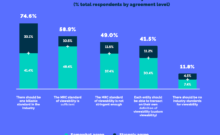Kristen Lemkau manages a $5 billion marketing budget as the CMO of JPMorgan Chase. Lemkau stopped by Business Insider for an interview with CEO Henry Blodget . She explains why JPMorgan Chase has retreated from an all-in digital marketing strategy and moved some money back to TV even though fewer people are watching. Following is a transcript of the video.
Henry Blodget: And when you look at the different media that you have available to you, most of studies will say that younger folks, under 50, just not watching a lot of television anymore. How do you reach that generation?
Kristen Lemkau: When you look at all the numbers, it shows that TV is just falling off a cliff and 18-24 has gone down 52% since 2001. My own kids are nine and 11, I do not think they have ever voluntarily turned on the TV themselves. So that flywheel is just happening at a hugely accelerated pace. The easy answer is, go all in on digital, and we’ve done a lot on digital. But as you know, digital can be the Wild West and it’s not for the faint of heart and the metrics are funky and the fraud and viewability and brand safety, all of these other nightmarish things that we know.
So we’ve retreated a little bit from an all-in digital strategy and we have gone back to TV a bit. Because people are watching are live sports or live events. And you still can get a fair amount of value. All of our models still show that the kind of TV that we’re doing is working and I think because of what’s happened in digital and the awareness that most marketers have realized how their dollars can go awry, you have a flight back to quality — quality digital as well.
Blodget: And what about YouTube? The folks in digital know that there’s this huge pot of money still being spent on television and in fact, your company and others have moved money back to TV. YouTube wants to fix the issues, yet it just seems like every few months there’s another scandal. Facebook, too.
Lemkau: YouTube is different. We weren’t big on YouTube, mostly because I just hate preroll as an ad unit. I think it’s one of those things you don’t have the right to interrupt a consumer’s experience in a digital environment when they are a click away from infinite choice. But we were on there and we never saw our ads next to some of the terrible things that the other brands did. But we just shut down because who’s going to take that risk? We went back and forth with Google and they were tremendously helpful, but we realized why would I change the standards for YouTube that we’re holding every other publisher to? And we had to go back on a white-list approach, and so we’re on their today. The real issue is the ad unit and I’d love to find a way that we can collaborate on more content so you’re not forcing a consumer to watch it. And then you feel good about it because it’s viewable and it’s a human and it doesn’t measure that you’ve massively pissed off that consumer and they may not buy your product.
Read More at The Original Article: www.businessinsider.com









